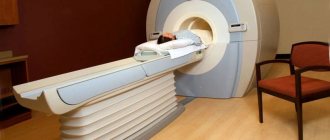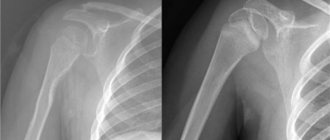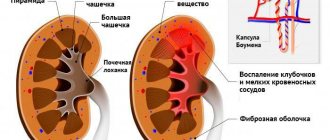Video colposcopy - what is it?
Video colposcopy is one of the examination methods in gynecology. The diagnostic procedure is painless and allows the doctor to see the slightest changes in the organs and, if necessary, collect cells for biopsy or cytology.
The examination is carried out using a video colposcope - an optical device equipped with illumination and magnifying optics. The device is connected to a computer, all data is displayed on the monitor and recorded on the hard drive. This allows you to carefully examine the surface being examined in photographs and videos without delaying the patient.
Colposcopy and video colposcopy have differences. In the first case, a simpler apparatus with optics and a light source is used. Before examination, the vaginal walls are separated using a gynecological speculum. The whole procedure lasts about 10 minutes. The doctor directly examines the condition of the walls and records the data in the patient’s chart. Read more about colposcopy→
With video colposcopy, a more powerful magnification of the examined surface occurs - changes are visible at the earliest stages of the disease.
The results are displayed in the form of photographs and videos, which allows several specialists to take part in the diagnosis at once. Often, the patient’s ability to independently see pathological changes in her organs makes her more responsible and organized in the treatment process.
Advantages of the method compared to others
The essence of the method is a combination of digital processing of images obtained during conventional colposcopy. A video camera is attached to the colposcope, the image is digitized, and in this form it is assessed by a doctor. Several specialists can monitor what is happening on the screen of the video colposcope, which greatly facilitates the consultation decision on treatment.
Color video colposcopy can be combined with chromocolposcopy - staining tissue with special dyes, colpomicroscopy - examination at high magnification, cervicoscopy - examination of the cervical canal.
Survey data can be stored on a computer indefinitely, which will allow you to return to the picture repeatedly and evaluate the results. In addition, the videos can be compared over time and a competent conclusion can be made about the effectiveness of treatment and the progression of the process.
Indications and contraindications
Video colposcopy in gynecology is indicated for women of all ages, as it is aimed at identifying a wide range of diseases. For preventive purposes, this procedure must be carried out at least once a year.
Video colposcopic examination can reveal dysplasia, leukoplakia, erythroplakia, and erosion. In addition, this method allows for early detection of cervical cancer (all forms), endometriosis, endocervicosis, and papillomas. The earlier these diseases are diagnosed, the higher the likelihood of their complete cure and prevention of complications.
There are situations when video colposcopy is contraindicated. These include:
- the first 2 months after the birth of a child or surgical intervention on the organs being studied;
- the period after treatment of cervical diseases with chemical methods using acid-based drugs (1.5-2 months);
- the period after cryodestruction procedures, diathermocoagulation, laser cauterization of blood vessels or evaporation of altered cells (1.5-2 months).
What is video colposcopy and how does it differ from colposcopy?
Colposcopy and video colposcopy are diagnostic examinations of the vaginal part of the uterine cervix and vaginal walls. Using these techniques, you can assess the condition of the mucous membranes of the vagina and uterus, detect lesions and inflammation, erosion, tumors and other neoplasms. During a colposcopic examination, the doctor visualizes the size and shape of the uterine cervix, the shade of the vascular pattern and tissue structures, the relief of the mucous membranes, as well as the presence and boundaries of tumor formations.
The main difference between video colposcopy and simple colposcopy is the ability to broadcast the received information onto a monitor screen and save it.
Video colposcopy differs from conventional colposcopy in its ability to document the examination—to record the information obtained in a digital format. Modern colposcopes are equipped with auxiliary video and photo recording functions, which allows the doctor to reduce diagnostic time and further study the data obtained. Thanks to recorded photo or video materials, you can consult with another specialist without repeating the examination.
Another difference between video colposcopy is the presence of equipment with more powerful optics, which allows the use of digital zoom (increasing the frame in size). There is no difference between the procedures for the patient. During the examination, the device is installed at a distance of 15-20 cm from the perineum, and the doctor uses a gynecological speculum.
Risk factors
Digital video colposcopy is a safe procedure. But there is a small risk of complications, such as bleeding, the development of infectious diseases, and pain in the lower abdomen.
After the procedure, a woman may experience unpleasant symptoms: bleeding more intense than during menstruation, chills and fever, severe abdominal pain, heavy discharge.
If you detect at least one of the listed signs, you should immediately consult a doctor or call an ambulance.
Video recording of colposcopy and colposcopic images
Video recording
Pictures
Vinegar test
Healthy cervix after treatment with 3% acetic acid. Cloudy mucus is visible. the surface of the mucous membrane is smooth and transparent.
Schiller test
The same neck after treatment with Lugol's solution. The mucous membrane (stratified squamous epithelium) was evenly stained dark brown.
Symptom "Pupil"
Healthy cervix in the middle of the menstrual cycle. At this time, the cervical canal contains a large amount of mucus, due to which the external pharynx expands and takes on a rounded shape - a symptom of a “pupil”.
Cervical erosion
Read more about cervical erosion in this article.
Cervix with ectopic columnar epithelium before and after treatment with 3% acetic acid and Lugol's solution.
- “Erosion” is ectopia of columnar epithelium.
- Test with 3% vinegar.
- Test with Lugol - the cylindrical epithelium is not stained, because its cells do not contain glycogen.
Cervical cyst
Dilated vessels are visible through the thinned mucous membrane of the cyst wall.
Condylomas on the mucous membrane of the vestibule of the vagina
Papilloma on the skin of the perineum
Back to contents
How does the preparation and procedure go?
No special preparation is required for video colposcopy. Two days before the procedure, you need to abstain from sexual intercourse, and a few hours before the procedure, do not shower or wash yourself. Before going to the office, you need to empty your bladder and, if possible, your bowels.
How is video colposcopy performed? The woman sits in the gynecological chair as usual. First, the doctor conducts an examination using a mirror. Then the device is secured on a tripod at a distance of 10-15 cm from the vagina. Without removing the mirror, he directs a beam of light into the genital slit.
Through an optical system, it examines the condition of the tissues and, if necessary, takes material for a biopsy. The progress of the procedure is recorded on the computer's hard drive. All manipulations are performed within 10-20 minutes.
How to prepare for colposcopy
Simple logic will help you understand how to prepare for cervical colposcopy. Obviously, for the most accurate examination result, any mechanical and physical effects on the cervix should be eliminated the day before.
Therefore, a woman should follow the recommendations of a gynecologist for several days before the scheduled examination:
- for 2 days before the study, refrain from sexual contact;
- stop using vaginal tampons, creams and other intimate accessories;
- refuse douching and intimate hygiene products. For washing, use only boiled water, cooled to room temperature;
- refrain from using any vaginal medications, unless otherwise agreed in advance with your doctor.
It is better to carry out colposcopy no earlier than a few days after the end of menstruation and no later than a couple of days before the expected start of a new cycle.
Advantages and disadvantages of video colposcopy
Video colposcopy of the cervix and vagina has advantages compared to other examination methods:
- allows you to detect diseases at a very early stage;
- gives the doctor the opportunity to accurately collect material for a biopsy, which subsequently ensures high reliability of the result;
- retains in full all information related to the course of the disease;
- allows you to reliably assess the dynamics of treatment thanks to photo and video recording;
- high accuracy of diagnosis, and as a result – adequate treatment and recovery;
- painless, minimal risk of complications.
Video colposcopy has no objective disadvantages. According to patient reviews, the only drawback is the difficulty of accessing free examinations (long waits for your turn, diagnosis by appointment) and its high cost in private clinics.
When is video colposcopy needed? Advantages of video colposcopy.
Video colposcopy is an indispensable part of an in-depth gynecological examination.
In combination with data from a gynecological smear analysis, colposcopy gives the doctor the opportunity to gain the necessary insight into the condition of the vagina and cervix. Video colposcopy allows you to accumulate data, which qualitatively improves diagnosis and allows you to achieve the most effective treatment.
Video colposcopy is especially important in the treatment of cervical erosion. If there is a suspicion of a focus of erosion, the doctor, using a video colposcope, can select the most successful image of the suspicious area, increase its size, change the brightness and contrast so as to accurately determine the condition of the cervical mucosa in this place. Video colposcopy makes it possible to see changes in dynamics and evaluate the quality and completeness of the surgical treatment performed.
Advanced video colposcopy
In addition to simple or overview video colposcopy, there is also an extended one. Its difference is that the examination of the cervix is carried out using special drugs that react in a certain way to pathological cells and secrete them.
Extended video colposcopy is performed using special tests: Lugol to detect glycogen in tissues, a solution of acetic acid or adrenaline to assess the reaction of blood vessels, trichotetrazole to determine tumor markers. The doctor can also use a probe: if, when pressing on the tissue, it sinks into it and causes bleeding, then the risk of cancer is high.
Video colposcopy of the cervix and vagina is a modern method for diagnosing gynecological diseases. It is informative, accurate and painless. All data is recorded on the computer's hard drive and can be used later.
Author: Olga Khanova, doctor, especially for Mama66.ru
Description of the device performing the procedure
Video colposcopy of the cervix and vaginal mucous membranes is performed with a special device. It has several parts. The product is equipped with a powerful magnifying device, thanks to which the doctor can detect even small and insignificant tissue changes. The device is connected to a computer monitor. It is worth saying right away that the procedure is almost painless. This question interests many patients who are afraid to agree to the study.
A video colposcope is a kind of device, one end of which is connected to the female organs, and an image is shown on the other. The optical instrument fixes a certain point (mucous tissue, cervix, labia), after which it magnifies the data several times and transmits it to the screen. If desired, the doctor can record the study on disk. This scheme allows you to monitor the dynamics and evaluate the result of treatment.
Video colposcopy procedure
Video colposcopy feels a little different from a regular examination. The doctor inserts a speculum into the woman and applies Lugol's solution, iodine or acetic acid to the cervix, which allows identifying the affected tissue. When the solution takes effect, the specialist, using a video colposcope (a binocular microscope with a video camera attached to it), begins to conduct an examination. During video colposcopy, the gynecologist can at any time save the image to a personal computer and demonstrate it to the patient on the monitor. In difficult situations, the process of video colposcopy can be observed on the monitor by several doctors. On average, the procedure takes 10-20 minutes. After video colposcopy, a woman should limit sexual activity for several days.










